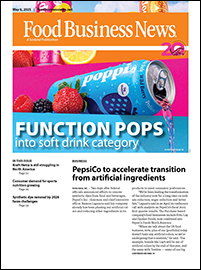WASHINGTON — Not much changed in the Dietary Guidelines for Americans 2020-2025 when compared to the guidelines for 2015-2020, but one non-change could lead to debate.
The updated Dietary Guidelines, which were released Dec. 29, went against the advice of a Dietary Guidelines Advisory Committee and kept the recommendation for added sugars at less than 10% of total calories per day, starting at age 2. Infants younger than age 2 should avoid foods and beverage with added sugars.
The updated Dietary Guidelines may be found here. The US Department of Agriculture and the US Department of Health and Human Services update the Dietary Guidelines every five years. Each time they appoint a Dietary Guidelines Advisory Committee, which, in a report issued in July, said the added sugar intake recommendation should be lowered to less than 6% of total calories.
The quantitative recommendations, however, did not change in the updated Dietary Guidelines because there was not a “preponderance of evidence” in the material the DGAC reviewed to support specific changes. The USDA and the HHS both encourage further studies on added sugar, including those that look for evidence of the health benefits from dropping to less than 6% of total calories from less than 10%.
 “Today, we are pleased USDA and HHS sided with strong scientific evidence and discounted the Dietary Guidelines Advisory Committee’s recommendation to lower the recommendation for added sugars intake to no more than 6% of daily calories,” said Courtney Gaine, PhD, president of The Sugar Association. “That recommendation was not justified given there was not a proper and thorough review of the totality of scientific evidence, but in the end, the agencies got it right and maintained the current recommendation of 10% of calories from added sugars.”
“Today, we are pleased USDA and HHS sided with strong scientific evidence and discounted the Dietary Guidelines Advisory Committee’s recommendation to lower the recommendation for added sugars intake to no more than 6% of daily calories,” said Courtney Gaine, PhD, president of The Sugar Association. “That recommendation was not justified given there was not a proper and thorough review of the totality of scientific evidence, but in the end, the agencies got it right and maintained the current recommendation of 10% of calories from added sugars.”
Mitchell S. V. Elkind, MD, president of the American Heart Association, said he was pleased with how the updated Dietary Guidelines stressed healthy eating, “but we are disappointed the USDA and HHS did not accept all of the Dietary Guidelines Advisory Committee’s science-based recommendations in the final guidelines for 2020, including the recommendation to lower added sugars consumption to less than 6% of calories.”
The FDA defines added sugars as sugars that either are added during the processing of foods or packaged as such. Sugar-sweetened beverages make up 24% of the average intake of added sugars for Americans age 1 and older while desserts and sweet snacks make up another 19%.
The updated version of the Dietary Guidelines for the first time included recommendations for pregnant and lactating women and infants under age 2.
Infants should be fed exclusively human milk for the first six months of life and be fed iron-fortified infant formula during the first year of life when human milk is not available. They also should be given supplemental vitamin D soon after birth.
Infants, at about six months of age, should be introduced to nutrient-dense complementary foods, including potentially allergenic foods along with other complementary foods. The foods should be rich in iron and zinc, particularly for infants fed human milk. For infants at high risk of peanut allergy, peanut-containing foods should be introduced between the ages of four and six months.
Intake of folate/folic acid, iron, iodine, choline and seafood was recommended for pregnant and lactating women.
While recommending limits on intakes of saturated fat and sodium, the updated Dietary Guidelines kept the same quantitative recommendations as the 2015-2020 version. Saturated fat intake should make up less than 10% of total caloric intake per day starting at age 2. Sodium intake should be less than 2,300 mg per day and even less for children younger than 14.

The updated Dietary Guidelines said 85% of daily calories should come from nutrient-dense foods and beverages since they provide vitamins, minerals, and other health-promoting components and have little added sugars, saturated fat, and sodium. When prepared with no or little added sugars, saturated fat and sodium, foods that serve as examples of nutrient-dense are vegetables, fruits, whole grains, seafood, eggs, beans, peas, lentils, unsalted nuts and seeds, fat-free and low-fat dairy products, and lean meats and poultry.
The Dietary Guidelines provides science-based recommendations designed to create healthy dietary patterns as a way to combat diet-related diseases. About 74% of US adults are overweight or have obesity, according to the Dietary Guidelines. About 18.2 million US adults have coronary artery disease. Almost 11% of Americans have type 1 or type 2 diabetes. More than 250,000 women will be diagnosed with breast cancer this year, and more than 1.3 million people are living with colorectal cancer.
The Dietary Guidelines are designed for use by health care professionals and policy makers as they reach out to the public and provide the nutritional foundation for federal nutrition programs.
“At USDA and HHS, we work to serve the American people, to help every American thrive and live healthier lives through access to healthy foods and providing nutrition recommendations,” said US Secretary of Agriculture Sonny Perdue. “With the release of the Dietary Guidelines, we have taken the very important step to provide nutrition guidance that can help all Americans lead healthier lives by making every bite count.”
Alex Azar, US Health and Human Services Secretary, added, “The science tells us that good nutrition leads to better health outcomes, and the new Dietary Guidelines use the best available evidence to give Americans the information they need to make healthy decisions for themselves and their families. USDA and HHS have expanded this edition of the Dietary Guidelines to provide new guidance for infants, toddlers, and pregnant and breastfeeding women, helping all Americans to improve their health, no matter their age or life stage.”





